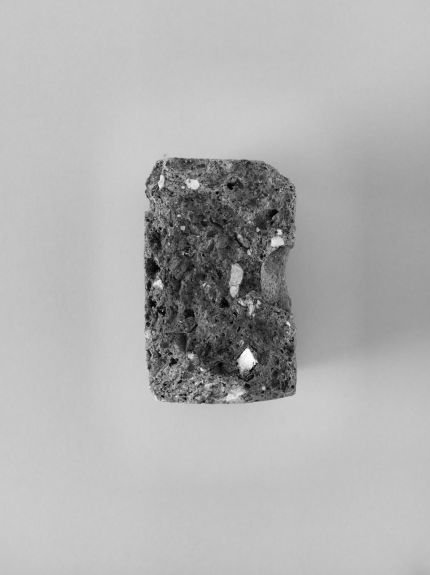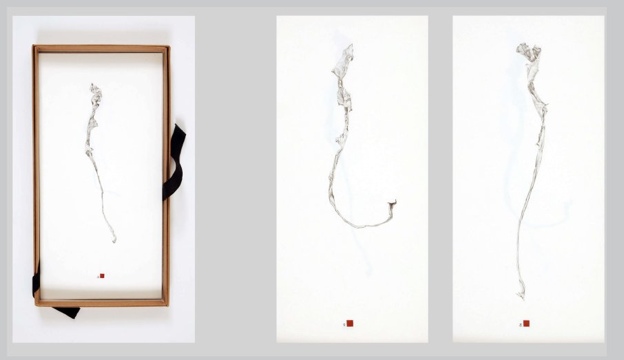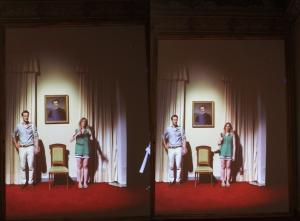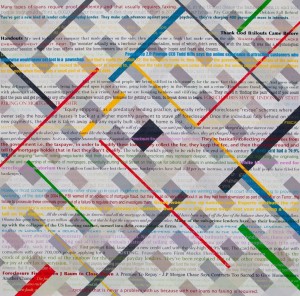Artists: Beatrice Haines, Colin Glenn, Janne Malmros, Laura Culham, Stephen Gill
Et Cetera explores the notion that meaning and significance can be found in that which is commonly deemed uninteresting or unworthy. The exhibition focuses on various overlooked elements in the increasingly repetitive urban environment: both human detritus and the less glamorous areas of nature – the grey-green moss that lurks between the cracks in the cobbles. In addition, the show acknowledges that through repetition in different contexts (particularly repetition in the form of painstakingly produced objects and artefacts) something new and thought-provoking may emerge.
The exhibition is to include a recent series of work by acclaimed photographer Stephen Gill; drawings, small-scale sculptures and an artist’s book by Laura Culham; delicate drawings by Beatrice Haines; painstakingly crafted paper structures by Janne Malmros; and photorealist drawings by Colin Glen.
Curated by Tom Jeffreys.
www.hoxtonartgallery.co.uk/
Et Cetera – A reappraisal of the mundane
The works that make up Et Cetera concern themselves with marking that which is largely considered unremarkable. Discarded rocks or lumps of concrete; molecules of dust; growths of grubby lichen; broken pieces of china: Et Cetera consists of a series of strategies of reappraisal – strategies that converge, for the most part, in an ability to find or create beauty in those oft-overlooked elements of the contemporary urban environment, the grey-green moss that grows between the cracks in the cobbles.
It is this ‘finding or creating’ – this marking – that forms the exhibition’s second strand. The act of making a mark, the process by which the unremarkable is remarked upon, is, in every case here, a laborious and repetitive one. Et Cetera concerns itself not with the flash of inspiration nor the slick product of the mechanical or the digital, but with the almost tender care that comes from repetition, through labour over time.
And other things…
The title of the exhibition comes from the Latin for ‘and the rest’. It is a phrase – usually shortened to ‘etc’ in everyday usage – that makes note of those things that, in themselves, are unworthy of note – those things left over, unremarkable.
This is most evident in the subject matter utilised by four of the artists in Et Cetera. Beatrice Haines, for example, has produced work that depicts objects like gall stones, limescale and thimbles. Colin Glen meanwhile draws worthless wire objects that he found on a building site back in the late 1990s. Stephen Gill photographs bricks, discarded betting slips, the toilet roll in hotel bathrooms. All are the kind of small, insignificant objects so easily overlooked in the rush of daily life, but objects that nonetheless seem to posses a strange fascination.
Perhaps this facet of the exhibition is best exemplified by the work of Laura Culham. Culham completed her MA in printmaking at the RCA at the end of 2011, but unlike many artists of her age she immediately left London for the relative calm and quiet of Bushey in Hertfordshire. In some ways, this sees a return to the time of her BA in the sleepy seaside town of Falmouth, but there’s also something implicitly defiant about Culham’s rejection of the London art world echo chamber.
This independence of thought can be seen most clearly in the art itself. Where many young contemporary artists seek to make their mark through the big statement, to grapple with the big, obvious issues – life, death, sex, identity etc – Culham speaks instead with the soft voice of precision. Past works have included painstaking paper sculptures of moths (Untitled – Common Moths, 2009), detailed drawings of a seagull’s wing (Wing of a Seagull, After Dürer 2009) or printer’s cloth (Scrim, 2008), copper plate etchings of gravel (Gravel, 150 pieces, 2010) and hand-coloured blind embossing of chewing gum scraped off the ground (Pavement, London, 2010).
For Et Cetera, Culham is showing two loose-leafed artist’s books – one that portrays broken pieces of blue and white china, collected from across the country over a period of several years (Fragments, bifold, 2012); the other splodges of moss and lichen, depicted in exquisitely detailed watercolour (November 3rd 2009, Graveyard, 2012). It is through these tiny objects of insignificance, discarded and rediscovered, that Culham creates works that are simultaneously easily overlooked and worthy of the same intense scrutiny that goes into their production.
Like Culham, Beatrice Haines also focuses on the small and the apparently trivial. Frequently working with a trinocular stereoscopic microscope, she too produces painstakingly detailed drawings, but in a very different style: whilst Culham imbues inconsequential objects with an almost lyrical charm, Haines makes a more graphic line, with works such as Hands (an ink drawing) or Grapestalk (a lithograph) taking such a forensic approach to detail that the objects under the microscope become almost grotesque.
Paper Traces
Part of the difference between Haines and Culham may stem from the relative significance of the objects themselves. Where Culham’s moths or broken china are relatively unexplained, Haines’s objects come imbued with a specific and pre-existing narrative: the gallstones and thimbles, for example, both belonged to Haines’s grandmother and now act as a kind of relic or trace. Following her death, these strange little objects are all that is left – a reminder of what once was.
For both Haines and Culham, the act of looking with this kind of intensity where others would only glance is not a deliberate act of judgement. For Stephen Gill however, this process of re-examination has a more overtly political edge. Like Haines, every discarded object exists for Gill as a lasting trace of the narrative that brought it there. Gill – who has lived in East London since the mid-1990s – has seen the area change beyond recognition and is one of the most thoughtful chroniclers of this change. He’s produced an incredible range of work, that documents the long-cleared market of Hackney Wick (Hackney Wick, 2004), or looks at the backs of billboards (Billboards, ongoing) or depicts those tender little moments when lost tourists stop to ask for directions (Lost, 1996).
Between 2004 and 2007 Gill produced a series of images of the toilet paper in hotel bathrooms across the world – specifically the way in which cleaners fold up the ends of a roll to signify that the room has been cleaned. Similarly, in another project, Gill collected and photographed discarded betting slips left on the floors of various East London betting shops, observing the variety of (mostly unobserved) ways that people react to the disappointment of losing. In both series – Anonymous Origami and A Series of Disappointments – it is not so much the object itself that is of interest to Gill as the personality of the unknown individual that it indicates.
Et Cetera includes a number of images from Gill’s Off Ground series, produced in August 2011 in response to the London riots. Whilst mainstream newspapers and social media fused into a self-repeating stream of panic and rumour, Gill sought out something more concrete – in some cases, literally. Over the three days of the riots, he collected rocks and lumps of stone or concrete that had been used as missiles by the rioters. In several instances, Gill saw from camera footage on the TV where a particular missile had landed and then went out to collect it.
Gill then took all of the collected debris back to his studio, and shot each one in identical conditions – over three consecutive nights to ensure precise consistency of light – with a £3,000 rented lens more often associated with medical photography. This careful, time-consuming, repetitive process both eschews the media’s desire for immediacy and results in images whose surfaces are rich with strange, beguiling detail.
In this context, a few discarded rocks become a means by which to move beyond the feedback loop of media coverage. With images of fire and violence immediately ubiquitous, there is a force that comes from the absence of force. In these works, an object – and its image – become something other than simply mediated, and something more than just immediate. Haines talks of “the relationship between emotion and sterility” as a central conflict in her work, and something similar could be said for Gill’s approach here.
—
And so on…
Et Cetera has a second subtly different meaning. Employed at the end of a series of actions as opposed to a list of nouns, ‘etc’ suggests a continuation into the future of that which has already been mentioned. In short, ‘etc’ names repetition.
Repetition features prominently, repeatedly, in the works that make up Et Cetera: from the grey rows of rocks of Gill’s Off Ground series to Haines’ images of gallstones, where 3D scans have produced results reminiscent of repetitive topographic charts. But the issue is perhaps most evident in the works of Janne Malmros. Malmros’ work is concerned with repetition at its most fundamental – the questioning of whether pattern is something essential, inherent in nature, or externally imposed upon it. From a beautiful stop-motion animation consisting simply of different leaves fallen from a Gingko Biloba tree in UCL (Ginkgo 01404 – The Whole Crown, 2009) to marking new patterns onto illustrations of butterflies in a nature guide book (Black- veined White, 2010), via the use of entomologists foam and pins, and the terminology of algebra: Malmros is interested in the relationship between nature and the sciences – to what extent is pattern inherent? In what ways do our methods of classification fuse (and indeed, confuse) the constative and the performative?
For Et Cetera, Malmros presents work from an ongoing series entitled Truncated Elements. These works are ostensibly prints, but the actual print – screenprint, woodblock etc – is frequently only the starting point for a practice that employs careful cutting and folding to exploit the potential of the repeated pattern. At the heart of these works is a careful balance between the repetitively regular and the tiny, barely noticeable imperfections that accompany the handmade process. For Malmros, pattern exists both as itself – repeated, two-dimensional – and as a kind of blueprint for the three-dimensional construction to come. As in Jacques Derrida’s concept of iterability, repetition here contains within itself the seeds of difference.
—
And so forth…
As well as naming repetition, this second sense of ‘etc’ also names the absence of repetition; the actual specific iterations being too repetitive, too obvious, to warrant listing in full. It is precisely this repetition – that is so frequently considered unworthy of mention or scrutiny – that informs the various practices on show. Consisting of Et Cetera written out in full, the title seeks to draw notice, in a very small way, to the repetitive actions of the artists themselves.
This idea of repetition – and its relationship to representation – is of particular importance for Colin Glen. Like Gill, Haines and Culham, Glen collects found objects and reproduces them in image form. And like them, the objects are by and large intrinsically worthless – his recent solo show at TJ Boulting, entitled From Confusion to Clarity (February-March 2012), focused on just two found wire objects – a tangled ball and a simple circular ring found on a building site in the late 1990s.
But where the subjects of Gill and Haines are often selected for the narratives they re-trace, for Glen, the object is of secondary importance to the process that follows: a painstaking and repetitive layering of pencil drawing – from the lightest H through to the darkest B – where each stage has to be, as he puts it, “perfect”. In a talk on 20th March 2012 to accompany his solo show at TJ Boulting, Glen talked about both the objects that he chooses to represent (“the more inauspicious the better”) and the labour-intensive process by which he does so. “It is not to do with impulse – the labour is really vital. It is just something that you do.” Again, the creative process is calm, considered and very time-consuming. A single drawing can take Glen over 300 hours.
And yet Glen also spoke of a past job as a photographer of other people’s art works. “Your job as a photographer of art is to not be there,” he said. “Your job is to be absent.” This is something that has continued into Glen’s fine art practice, and further links his work to that of Culham and Gill: the attempt to efface the hand of the artist. Not only is this an ultimately impossible task, but there’s also a certain irony about an artist spending so much time on a work only to then conceal their own agency.
It is at this point that Malmros’ work may be seen as a kind of visual representation of the processes undertaken in the practice of all the artists here, her own included and Glen’s in particular. If one sees her work as in some ways a visual representation of the Derridean concept of iterability – the idea of repetition as both a re-affirmation and a potential for difference – then the Truncated Elements series acts to foreground the very processes at work throughout Et Cetera and serves as a kind of meta-commentary on the exhibition itself. Through rigorous repetition of an action, something different emerges – in Malmros’ case, tiny gilded paper structures that catch the bright gallery light and the passing eye. The representation of representation, as it were.
—
Ctr Alt Repeat.
In a post-industrial, fully digitalised landscape, this whole approach might be considered something of an anachronism. Why spend so much time and care to produce something that could be rattled off on a mechanised production line or reproduced digitally in seconds?
One of the interesting points that has emerged over the course of curating Et Cetera is the way in which most of the works that make up the exhibition (with the possible exception of Colin Glen’s) do not come across well online. Unlike many exhibitions these days, Et Cetera does not translate well to the computer screen. It resists appropriation by the digital; it must be visited in person.
Partly this is simply an issue of scale and colour – tiny drawings and subtle greytones rarely translate well to pixels – but there’s also a certain irony about an exhibition that explores representation being itself so resistant to digital reappropriation.
To some extent this serves to reinforce one of the exhibition’s central tenets – that repetition always contains within it a seed of difference. And there’s something exciting about the fact that the works must be seen up close – the viewer paying as much attention to detail as the artists.
That is not to say, however, that Et Cetera champions some kind of anti-technological Ludditism. Gill utilises expensive camera lenses, Haines the latest 3D scanners, for example. And the exhibition includes Haines’s large image of a microchip – bland, repetitive, ubiquitous, hidden – and a kettle element – a small-scale etching based on the discovery that limescale is very similar in terms of chemical make-up to coral. So rather than a stance that is anti-technological, there’s more an uneasy kind of relationship with technology. One might see it as a stance that includes technology within its field of view.
In short, there is a desire to bear witness to that which gets left behind, and that includes technology – which is always the fastest in the race to obsolescence. If anything, therefore, an increasingly technological, plugged-in world only emphasises the importance of the works in Et Cetera – works which exist as repetitions in time, and are themselves subject to the processes they depict and enact.
—
Tracing Paper
The ubiquity of the computer screen, and the always-mediated nature of contemporary image consumption, actually serve to sharpen Et Cetera’s focus on the specificity of the chosen medium. This is something ironised by both Glen and Culham – Culham draws ink blots (Ink Blots, 2008) whilst Glen also paints with graphite powder in oil (Confusion to Clarity, 2012, among others) – but it’s also a serious matter, crystallised by the decisive shift to gold in Malmros’s work.
Each of the artists involved in Et Cetera has an almost unhealthy obsession with paper thickness and density. Gill has noted the irony of handling prints from the Off Ground series with white gloves, but he has also published them on cheap newspaper (with an accompanying essay by Iain Sinclair) that is being distributed for free as part of the exhibition. The importance of paper is particularly important for Laura Culham, due to the large amounts of untouched paper in the finished work. For drawings, she usually uses Magnani Pescia Soft White for its combination of grain and tone, whilst working with varnishes necessitates something different; Cotman, Gummed Watercolour Paper was used for Fragment, bifold. As she herself puts it, “I feel each material choice is of equal weighting to content decisions, every minute choice makes for a considered whole.”
This considered approach to the choice of paper underlines the irony of the scrumpled up, discarded betting slips in Gill’s A Series of Disappointments. And it’s an irony that in some ways brings us full circle – to the computer-printed slip of paper that, because it no longer signifies the prospect of financial gain, is instantly deemed worthless. But to Gill, it signifies something else – the loss of a story, the story of loss. This then is one story of Et Cetera – the slow, repetitive process of finding meaning in that which has been discarded, lost, left over for a time.
—
Et Cetera may therefore be seen as a writing-out-in-full of art practice. It is not as simple as just creating value through the totting up of man-hours; the exhibition seeks to assert with subtlety the continued need to operate at the periphery, to document the shadows, to find and create interest where, ostensibly, there is none.
Tom Jeffreys, April 2012







